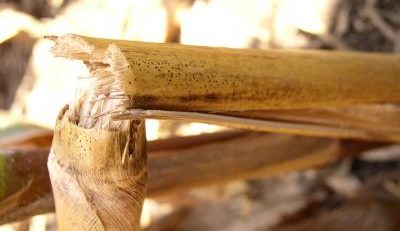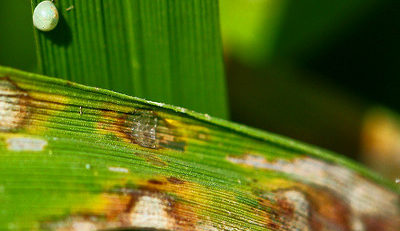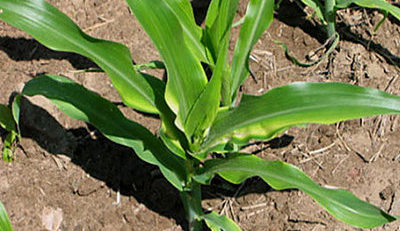Corn Nutrient Deficiency
Phsoderma maydes
Healthy Leaf:
Healthy leaves shine with a rich dark green color when adequately fed.
Phosphate Shortage:
Phosphate shortage marks leaves with reddish-purple, particularly on young plants.
Potash Deficiency:
Potash deficiency appears as a firing or drying along the tips and edges of lowest leaves.
Nitrogen Hunger:
Nitrogen hunger sign is yellowing that starts at the tip and moves along middle of leaf.
Magnesium Deficiency:
Magnesium deficiency causes whitish strips along the veins and often a purplish color on the underside of the lower leaves.
Drought:
Drought causes the corn to have a grayish-green color and the leaves roll up nearly to the size of a pencil.
Helminthosporium Blight:
Disease, helminthosporium blight, starts in small spots, gradually spreads across leaf.
Chemical Burn:
Chemicals may sometimes burn tips, edges of leaves and at other contacts. Tissue dies, leaf becomes whitecap.
Root Damage Symptoms
Healthy Roots:
Deep, spreading roots of healthy, high-yielding plant will crowd a half-bushel basket.
Phosphate Shortage:
Phosphate shortage during early weeks causes a shallow root system with little spread.
Rootworm Damage:
Rootworms prune heavily as they eat small roots, tunnel in larger ones.
Shallow Root System:
Poor drainage and hardpan are the causes of a flat, shallow root system. Corn with poor roots can’t stand drought and is easily blown over by high winds.
Discolored Roots:
Acid soil is indicated when the lower part of the root is discolored and decayed, particularly when brace roots shoot from the third or fourth node.
Pruned Roots:
Pruned roots are the work of a cultivator. Shovels were too deep and too close.
Twisted Roots:
Chemical damage makes roots writhe and twist. Joined brace roots are another symptom.
Ear Damage Symptoms
Normal Ears:
A normal ear on well fertilized high-producing corn weighs about two-thirds of a pound. It has well filled tips.
Large Ears:
Big ears weighing up to 1 lb. indicate that plant population was too small for most profitable yields.
Small Ears:
Small ears usually are a sign of low fertility. For better yields, boost fertilizer application.
Potash Shortage:
Potash shortage shows up in ears with poorly filled tips and loose chaffy kernels.
Phosphate Shortage:
Phosphate shortages interfere with pollination and kernel fill. Ears are small, often twisted and with undeveloped kernels.
Nitrogen Shortage:
Nitrogen is essential throughout the growing season. If plant runs out of nitrogen at critical time, ears are small and protein content is low. Kernels at tip do not fill.
Green Silks:
Green silks at maturity may be caused by too much nitrogen in relation to other elements.
Unpollinated Kernels:
Dry weather slows silking behind tasseling; kernels aren’t pollinated.






Leave a Reply